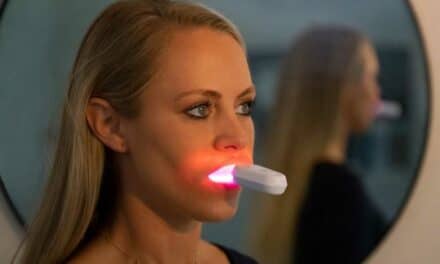A new prospective, peer-reviewed clinical study, published in the Journal of Clinical Orthodontics (JCO), concludes that when treating Class II malocclusions, AcceleDent’s SoftPulse Technology® speeds up molar distalization rates in the apex and crown while also reducing the number of days to move the upper molars into a normal, Class I relationship. The study, titled “The Effect of Vibration on Molar Distalization,” was conducted by S. Jay Bowman, DMD, MSD.
Manufactured by OrthoAccel, AcceleDent® uses patented SoftPulse Technology to speed up bone remodeling during orthodontic treatment by enhancing physiological bone turnover.
AcceleDent is an FDA-cleared vibratory orthodontic device designed to speed up orthodontic treatment by as much as 50% when used in conjunction with braces or aligners. The vibrations the device emits help to reduce patient discomfort during orthodontic treatment.
In the study, Bowman evenly divided 60 adolescent patients into two groups—a control group and vibration group. Patients in the vibration group were asked to use AcceleDent for 20 minutes daily by holding the device’s mouthpiece between their teeth. All 60 patients were nonextraction cases and each patient was treated with a miniscrew implant-supported device (Horseshoe Jet) for achieving distalization, the correction of the posterior position of the upper molars.
Bowman found that there was 71% more movement of the molar root apex (2.9mm vs 1.7mm per month) and a modestly significant 27% increase in crown movement (1.1mm vs .9mm per month) in the AcceleDent group than the control group. Additionally, the desired Class I molar relationship was achieved an average of 27 days faster in the AcceleDent group.
“From my previous retrospective investigation of vibrational effects on leveling and alignment of the mandibular dentition, a statistically significant 30% increased rate of leveling was revealed. It appears that there is a concurrent increase in the rate of molar movement when AcceleDent is used as a treatment adjunct during Class II malocclusion correction,” said Bowman, who practices at Kalamazoo Orthodontics in Michigan. “It was also interesting to note that AcceleDent had no impact on miniscrew failure rates.”
Bowman adds that he measured patient compliance throughout the study to accurately report the impact of AcceleDent compliance on study outcomes. Among the compliant patients in the AcceleDent group, the average molar movement was 1.23mm per month compared to .89mm per month for the noncompliant patients. The compliant group achieved Class I within 186 days and level mandibular dentition in 65 days. The noncompliant group achieved Class I in 220 days and level mandibular dentition in 106 days.
Bowman’s previous study on leveling and alignment appeared in the November 2014 issue of the JCO.








